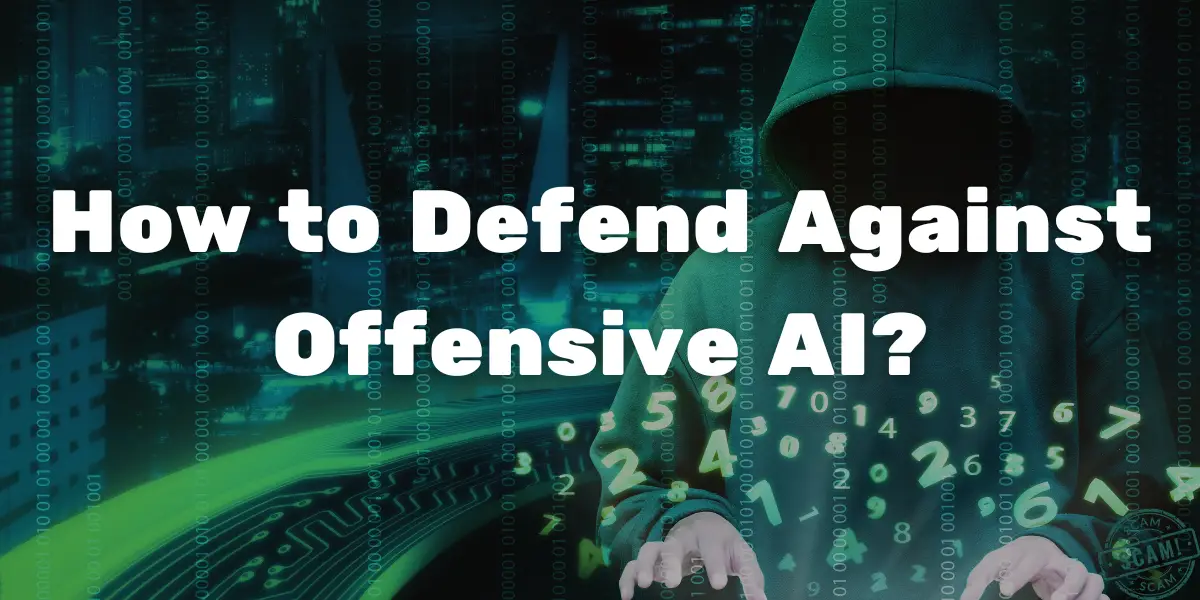How to Defend Against Offensive AI?

In the digital age, offensive AI has emerged as a significant threat, leveraging advanced AI technologies to conduct cyber-attacks and exploit vulnerabilities. This introduction underscores the urgent need to understand and defend against these sophisticated threats.
This article provides a comprehensive guide on offensive AI, detailing its characteristics, threats, societal impacts, and defensive strategies.
Table of Contents
What is Offensive AI?

Offensive AI refers to the use of artificial intelligence technologies to design, execute, and manage cyber-attacks. These systems leverage AI’s capability to learn and adapt, making them particularly effective and dangerous in cyber warfare. Unlike conventional cyber threats, offensive AI can process vast amounts of data quickly, identify vulnerabilities in real-time, and execute attacks at a pace and scale unmanageable for traditional security measures. The ability to autonomously modify its strategies and mimic human behavior makes offensive AI a formidable opponent in the digital realm.
Key Features of Offensive AI
Adaptability
Offensive AI systems are highly adaptable, allowing them to evolve their attack strategies based on real-time feedback from the target environment.
- Rapid learning: Can quickly learn from interactions and adapt to countermeasures.
- Dynamic adjustments: Modify attack methods to bypass enhanced security protocols.
Automation
The automation feature in offensive AI facilitates the execution of large-scale attacks with minimal human oversight.
- High-volume attacks: Capable of launching simultaneous attacks across various systems.
- Reduced human involvement: Limits the need for direct human control, increasing operational efficiency.
Precision
AI-driven attacks are designed with a level of precision that allows for targeted and highly effective cyber-attacks.
- Target specific vulnerabilities: Identify and exploit specific weaknesses in a system.
- Customized threats: Tailor attacks to the behavior and patterns of specific users or networks.
What are the common offensive AI scams?
Offensive AI enables a range of sophisticated scams that can be particularly challenging to detect and defend against. These scams often leverage AI’s capabilities to mimic human behavior or generate convincing fake content.
Deepfake Impersonation
Deepfake technology uses AI to create realistic audio and video impersonations of individuals. Scammers utilize these convincing fakes to manipulate public opinion, commit fraud, or engage in blackmail. Deepfakes pose a significant threat because they can undermine trust in media and communications, leading to misinformation and confusion. The technology’s ability to mimic voices and appearances so accurately makes it a potent tool for creating fake news or fraudulent communications that are difficult for the average person to distinguish from reality.
AI-Enhanced Phishing
AI-enhanced phishing involves using machine learning to automate and optimize phishing attacks. These scams are tailored to their targets using data mined from social media and other public sources, making the fraudulent communications incredibly personalized and more likely to succeed. AI systems analyze vast amounts of data to identify the most effective phishing strategies, often manipulating language and context to mimic legitimate sources. This type of scam is particularly dangerous because it can scale rapidly, targeting thousands or even millions of users at a swift pace.
Automated Social Engineering
Automated social engineering uses AI to create scenarios where users are manipulated into divulging sensitive information or performing actions that compromise their security. AI algorithms are used to simulate human interaction, often through chatbots or automated phone systems, to gain the trust of individuals. The AI can learn and adapt from interactions to become more effective over time, making it an evolving threat capable of carrying out complex deception campaigns. This form of AI scam is concerning because it combines the scalability of automation with the persuasive power of human-like interaction, leading to highly effective scams.
What are the impacts of offensive AI on society?
Offensive AI significantly impacts society by reshaping the nature of cybersecurity threats and increasing the scale and sophistication of cyber attacks. These AI-driven capabilities not only endanger individual privacy and security but also threaten national security, disrupt businesses, and challenge the integrity of crucial information systems. The societal implications are far-reaching, affecting everything from the trust we place in digital systems to the global political landscape.
- Privacy Violations: Offensive AI can automate the collection and analysis of vast amounts of personal data, leading to unprecedented breaches of privacy.
- Economic Disruption: Cyber attacks facilitated by offensive AI can target critical infrastructure, causing significant financial losses and undermining consumer confidence.
- Trust Erosion: The ability of offensive AI to generate convincing fake content and impersonate individuals erodes trust in media, governmental institutions, and personal communications.
- National Security Threats: Offensive AI enhances the capabilities of cyber warfare and espionage, posing direct threats to the stability and security of nations.
- Manipulation and Control: The technology can be used to manipulate public opinion, influence elections, and control societal norms, which can destabilize democracies and manipulate political outcomes.
Ethical and legal issues behind offensive AI
The deployment of offensive AI raises substantial ethical and legal challenges that require urgent attention from policymakers, technologists, and legal experts to ensure these technologies are used responsibly.
- Accountability: Determining who is responsible when an AI system autonomously conducts an attack is complex. This challenge involves tracing actions back to developers, operators, or even the AI system itself, complicating traditional notions of liability.
- Transparency: Offensive AI operations are often opaque, lacking in transparency necessary for regulatory and public scrutiny. This opacity makes it difficult to understand, audit, and govern the use of such AI.
- Autonomy versus Control: Balancing the autonomy of AI systems with necessary human oversight is crucial to prevent unintended consequences and ensure ethical use.
- International Law: The global nature of AI and cyber threats necessitates international cooperation to create standards and regulations that address offensive AI use across borders.
Future developments of offensive AI

As offensive AI continues to evolve, its integration into various cyber operations is expected to become more refined and widespread. Future developments are likely to focus on enhancing the autonomy and decision-making capabilities of these systems, allowing them to execute more complex strategies with minimal human intervention. This progression will likely see AI tools not only improving existing methods of cyber attacks such as phishing, malware distribution, and social engineering but also developing new forms of threats that are harder to predict and counter. Additionally, the convergence of offensive AI with other emerging technologies like quantum computing and the Internet of Things (IoT) could amplify its impact, leading to faster and more invasive cyber attacks. As these technologies advance, the arms race between offensive capabilities and defensive AI systems will intensify, necessitating ongoing innovations in cybersecurity. This dynamic ensures that offensive AI will remain at the forefront of cybersecurity challenges, continuously shaping the landscape of digital threats.
Ways to defend against offensive AI
Defending against offensive AI necessitates a multi-faceted approach that combines technology, education, and policy measures to enhance cybersecurity defenses across organizations and industries.
- Advanced Detection Systems: Deploy AI-driven security systems that can predict and neutralize threats before they cause harm.
- Regular Software Updates: Maintain up-to-date software to protect against known vulnerabilities that could be exploited by AI-driven attacks.
- Cybersecurity Education: Increase awareness and training to help individuals and organizations recognize and respond to AI-driven threats effectively.
- Collaborative Defense Strategies: Foster collaboration between private and public sectors to share threat intelligence and best practices.
Conclusion
The rise of offensive AI necessitates a proactive and informed approach to cybersecurity. By understanding the capabilities and threats posed by offensive AI, individuals and organizations can better prepare and defend against these emerging digital threats. The ongoing development of defensive strategies, coupled with ethical and regulatory frameworks, will play a critical role in safeguarding digital and societal infrastructures against the misuse of AI technologies.

